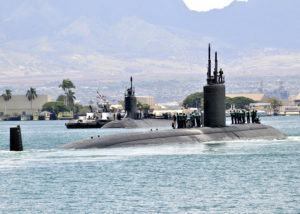
The U.S. Navy’s Virginia-class submarines have seen delays in production thanks to manufacturing bottlenecks and slowdowns caused by the Covid-19 pandemic. The delays affect not only the U.S. Navy, but the Australian Navy as well, which has signed deals to purchase nuclear powered submarines from the U.S. as part of the AUKUS alliance announced last year. The delays in production of Virginia-class submarines have ended any hope in Australia of getting submarines from the U.S. any time soon. The shortcomings have pushed submarine-building targets back for decades, reports Tory Shepherd of The Guardian. She writes (abridged):
Australia has close to zero chance of getting a submarine from the United States’ current program, experts say, as yet another report shows the US is struggling to meet its own needs.
Defence is facing a capability gap as the existing Collins-class fleet retires and hopes fade of getting a new submarine under the Aukus deal before 2040.
Under the Aukus deal, Australia will buy at least eight submarines from either the US or the United Kingdom.
Former defence minister Peter Dutton suggested the US might give Australia a couple of its boats, a suggestion that was largely dismissed.
The latest report to Congress on the progress of the US’s shipbuilding efforts show the submarines “experienced cost growth” in the early part of the program, and now there’s a shortage of spare parts, maintenance delays for existing boats, and concerns about the shipyards’ capacity.
Complications including, but not limited to, the pandemic have seen delays in production of the US navy’s Virginia-class submarines.
“Some observers have expressed concern about the industrial base’s capacity for executing such a workload without encountering bottlenecks or other production problems in one or both of these programs,” the report said.
The US is aiming to build its own fleet of at least 60 nuclear-powered boats, but the report released this week shows it will reach a minimum of 46 boats in 2028, 50 by 3032 and between 60 and 69 by 2052. It is trying to increase capacity, but will still struggle to meet its own targets for decades.



